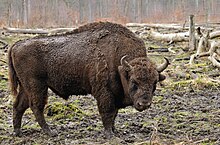Bergwisent
| Bergwisent | ||||||||||||
|---|---|---|---|---|---|---|---|---|---|---|---|---|

Killed Mountain Wisent (1898) |
||||||||||||
| Systematics | ||||||||||||
|
||||||||||||
| Scientific name | ||||||||||||
| Bos caucasicus | ||||||||||||
| Turkin & Satunin , 1904 |
The mountain wisent ( Bos caucasicus , partly also Bison caucasicus ), also known as the Caucasus mountain wisent or Caucasus wisent , is an extinct species of real cattle ( Bos ) that formerly lived in the Caucasus and is closely related to the bison . Genetic material of the mountain wisent is incorporated into two of the three existing breeding lines of the wisent - the so-called " lowland-Caucasus line " and the highland line - via a bull called the "Caucasus" (see Caucasus (wisent) ) .
features
The mountain wisent was smaller than the flatland form. He reached a shoulder height of 160 cm (compared to 185 cm) and a live weight of around 480 kilograms (in rare exceptional cases even more, from 700 to 800 kilograms). His fur was curly all over his body and also not elongated on the front, the mane and chin hair ("beard") were also shorter. The fur was a little darker overall. The hooves were noticeably shorter, but higher and more rounded towards the front.
Area
The species was restricted in its distribution to the Caucasus. In historical times it was separated from the southernmost population of the lowland wisent in the steppes on the Don by a distribution gap. However, it is considered likely that this gap can be traced back to hunting and that the area of distribution was previously contiguous, which is also indicated by subfossil bone finds. The distribution was limited to the West Caucasus, at least in historical times, there is no evidence of former occurrences east of the Georgian Military Road ( Raschīd ad-Dīn reports in his historical work that Abaqa , Ilchan of Persia, got in the mountains near Schahrud 1275/76 in the Forests "mountain buffalo" hunted. This makes an occurrence in historical times up to the Caspian Sea and Koh-i-Elburz seem at least conceivable). The forest zone in the north of the main chain and the northern foothills ("Chernye Gory"), in the catchment area of the Kuban and Terek rivers, was settled .
Discovery and Extinction
Reliable evidence of bison in the Caucasus is only available from the 18th century, earlier evidence is scattered and uncertain. At the end of the 19th century, all remaining evidence was in the Kuban area , between the upper reaches of the tributaries Beloe and Laban. Around 1890 the population was estimated at around 450 to 500 animals (maximum 700). The last retreat area was the large hunting reserve of the Tsars located here. In 1910 Filatov estimated the number to be "a few hundred". When state authority collapsed after the First World War and during the Revolution , the remaining population fell victim to poachers. An outbreak of foot and mouth disease , which was brought in with cattle , also contributed to the decline . In 1920 50 animals are said to have been alive. The establishment of the reserve in 1924 came too late to save the stock. The last wild animal fell victim to a poacher on Mount Alousa in 1926 (according to other information in 1927).
Systematics
The classification as species Bos caucasicus for the mountain wisent is recognized as valid by most mammal experts. However, there are also opposing opinions that do not consider this rank to be justified for the population. In the manual “Mammal Species of the World” caucasicus is regarded as a synonym of the nominate form of the bison Bos bonasus . Sometimes the mountain wisent was also considered a subspecies of the bison, but a revision of the hornbeam from 2011 sees it as an independent species.
Individual evidence
- ^ A b c d V. G. Heptner, AA Nasimovich and AG Bannikov: Mammals of the Soviet Union (Mlekopitayushchie Sovetskogo Soyuza) English edition. Volume 1: Artiodactyla and Perissodactyla. Smithsonian Institution Libraries and The National Science Foundation, Washington, DC 1988 (translated for the Smithsonian Institution by PM Rao, first published by Vysshaya Shkola Publishers Moscow, 1961), pp. 557-599 ( [1] )
- ↑ Ninell Melkadze, Nargiza Ninua and Izabella Skhirtladze: Catalog of the type specimens of Caucasian large mammalian fauna in the collection of the National Museum of Georgia. Tbilisi, 2009, pp. 1–64 ( download )
- ↑ Lidia V. Zablotskaya, Mikhail A. Zablotsky and Marina M. Zablotskaya: Origin of the Hybrids of North American and European Bison in the Caucasus Mountains. In: Zdzisaw Pucek (Ed.): European Bison. Status Survey and Conservation Action Plan. IUCN The World Conservation Union 2004 ISBN 2-8317-0762-5
- ^ Peter Grubb: Order Artiodactyla. In: Don E. Wilson, DeeAnn M. Reeder (editors): Mammal Species of the World: A Taxonomic and Geographic Reference. 3rd edition. Johns Hopkins University Press, 2005
- ↑ Colin Groves and Peter Grubb: Ungulate Taxonomy. Johns Hopkins University Press, 2011, pp. 1–317 (p. 114)
Web links
- Protecting bisons and the world natural heritage - NABU International project in the Caucasus , accessed on April 7, 2013.
literature
- Małgorzata Krasińska and Zbigniew Krasiński : The Wisent , The New Brehm Library Volume 74, Westarp Sciences, Hohenwarsleben 2008, ISBN 978-3-89432-481-0 .

